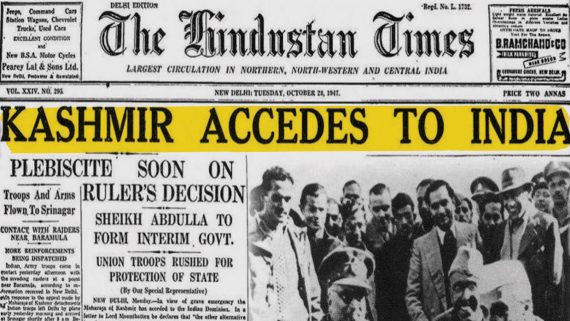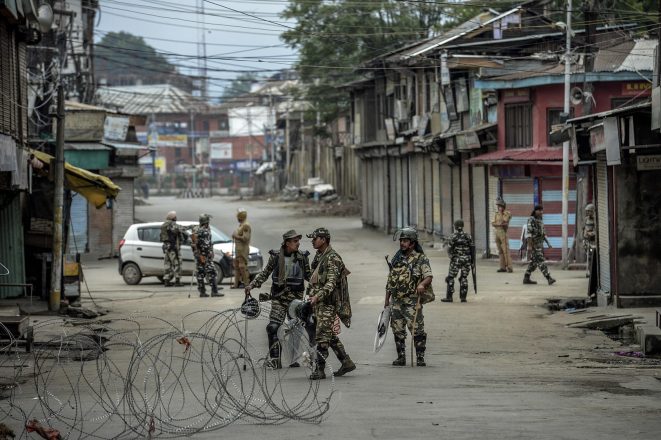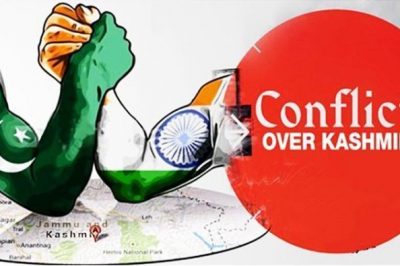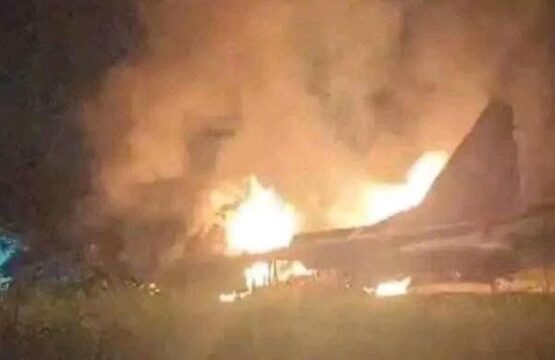Every year, Pakistan, along with the other international communities, observes Kashmir Solidarity Day on February 5. This day represents the recognition of Kashmiri’s unity, the struggle for freedom, and their martyrs fighting for the freedom of their motherland under the illegal occupation of India. Pakistan has consistently raised the voices of the innocent Kashmiris for their right to self-determination and freedom on every platform and showed brotherly support in the face of moral, diplomatic, and political forms.
Partition of British India 1947
Under the Indian Independence Act of 1947, British India was divided into two independent dominions: Pakistan and India. The choice was given to the Princely States to either join any of the two dominions or to operate independently. Like other independent states, Kashmir was a Muslim-majority state governed by the Hindu ruler Maharaja Hari Singh. Singh decided that Kashmir would remain independent and not be annexed by any Dominions.
First Indo-Pak War of 1947-48
After the decision of the Monarch not to join any dominion, the Muslim majority people of Jammu and Kashmir feared that the Maharaja of Kashmir would accept the offer of India and accede to India. This fear led to what we know as the First Indo-Pakistan War or Kashmir War in October 1947.
Today, the rebel movement or first action was seen in Pakistan’s area, Poonch, Azad Kashmir. This movement took an advantage when the other tribe members from Pakistan later joined the fight. Analyzing this problematic situation, the Maharaja of Jammu and Kashmir turns his side to the newly formed state of India to seek help in crushing the rebels. The fear of Kashmiris became a reality when, in exchange, Singh agreed to join India, which sparked the first-ever Indo-Pak War in the region of Kashmir.

Call for Ceasefire by UN in 1949
The War mesmerized global attention when the United Nations Security Council intervened and brokered a ceasefire 1949 between the two countries. The Indo-Pak war was a threat to regional peace and stability, causing a fear of disruption that could spread out, thus bringing the attention of the UN Security Council to resolve the Kashmir conflict.
United Nations developed the formula as it draws a line between Pakistan and India, with each state controlling its side. It is not done yet; the UN also advocated giving the right to Kashmiri people to cast their vote and make the decision to join either of the two countries. UN also advised the Indian troops and Pakistani local tribespeople to withdraw from Kashmir’s soil and let the people of Kashmir decide their future independently and without any fear.
It is noted that Pakistan also fought a War with China in 1962 in the Kashmir conflict. Parts of the Kashmir region were claimed by China, which led to a dispute between Pakistan and China. This issue was resolved when Shaksgam Valley was ceded to China by Pakistan to resolve border tensions with the neighboring country.
1965 Indo-Pak War: The Second Conflict
Following the UN Security Council’s decision to conduct a vote in Kashmir regarding the region’s future, determining whether to join Pakistan or India. Unfortunately, voting never happened there as Pakistan claimed that the Muslim majority people of Kashmir rightfully belonged to Pakistan. India’s narrative was that Kashmir was handed over to them by Maharaja Hari Singh as per the deal. These two narratives caused another war between India and Pakistan in 1962 when the second Indo-Pak War was fought in the region. The War began as Pakistan’s Operation Gibraltar, which was an action of insurgency to push back the Indian forces from Kashmir.
The operation took place to answer the Indian force’s violation of the Line, which was drawn earlier as the troops intruded into Pakistan’s area from the Rann of Kutch in 1965. Pakistan Army took immediate action, and the Indian forces were ejected from the region; as noted, it was a fully armed action that was settled down when Pakistan proposed a ceasefire, and latterly, India accepted it.
Also Read: Pakistan’s Relationship with FATF and its Impact on the Country’s Economy and Foreign Policy
The War ended again, but the Line between Jammu and Kashmir remained. An agreement was signed, disengaging the tensions between the two countries, but Kashmir was still divided.
1971 Indo-Pak War: The Third Strife
Now, the question comes to mind: what did Kashmir have to do with the 1971 Indo-Pak War? The scenario is very connecting because this time, the main focus was not Kashmir but East Pakistan, formally known as Bangladesh. West Pakistan faced tensions with the Eastern Wing after the general elections, and the power was not deliberately delivered to the right ones. In response, resistance movements were raised to restore what was rightly theirs. Many argue that India helped these rebels fight for their freedom, which dealt Pakistan a vast loss in the face of its Eastern Wing, which became a new country called Bangladesh.
The loss of its Eastern Wing, with the involvement of India helping out rebels, caused tensions to rise between India and Pakistan, which now made Kashmir more critical than ever before. The region has seen several military troops and armed vehicles from both sides of the Line of Control (LOC).
Kashmiri Freedom Movement: The Era of 90’s
Jammu and Kashmir Liberation Front was the most critical group active in the region, fighting for the freedom and rights of the Kashmiri people. The group started recruiting the Muslim youth for the independence fight for Kashmir.
This group became one of the most potent entities in Jammu and Kashmir by the mid-90s when they dominated most of the region by resisting the Indian Military occupying the territory. Along with that, several young individuals joined the Kashmiri Freedom Movement voluntarily, adjoining the fight against the violence on innocent Kashmiris and illegal occupation of their land.
In response, the Indian Military deployed approximately 500,000 troops in Kashmir. They also showcased incredible military force by cracking down on the protesters and the fighters, resulting in the killing and disappearance of several unarmed civilians in Kashmir.

1999 Fourth Indo-Pak War: The Recent Conflict
The Fourth Indo-Pak War, also known as the Kargil War, was fought between Pakistan and India in the Kargil district of Jammu and Kashmir in 1999. But this time, the conflict was triggered by the Pakistani troops. Some of the narratives present that these were disguised Kashmiri militants who entered the strategic positions of the Indian side (Dras, Kaksar, and Mushkoh) across the Line of Control. Indian Military and Air Force took immediate action against this infiltration and launched air strikes to push them back. Both sides witnessed huge losses where the casualties of Pakistan and India were 400+ and 527, respectively.
United States intervened and tried to resolve the conflict as U.S. President Bill Clinton met with the Prime Minister of Pakistan, Mian Muhammad Nawaz Sharif, and advised him to call back all Pakistani troops and paramilitary forces from Kargil. After that, Pakistani forces drew back from the Indian-occupied Kashmir, and the Indian army advanced towards Tiger Hill and retook the Jubar Heights. Later, Indian Prime Minister Atal Bihari Vajpayee called Operation Vijay a success, and Pakistan lost this War on the diplomatic front.
Balakot Airstrike 2019: India’s Violation of de facto Border
On February 26, India violated the border laws and conducted airstrikes in the Balakot region of Pakistan. India alleged that they had completed this airstrike against the terrorist training camp. But the truth has to be uncovered as the open-source satellite images revealed no signs of any camp on the site.
Balakot Airstrike
In retaliation, Pakistan’s Air Force shot down an IAF Mig-21 Bison fighter aircraft in a dogfight and captured its pilot named, Abhinandan Varthaman, who was later returned in March.
Revocation of Article 370 and 35-A
Article 370 was the foundation on which the Jammu and Kashmir region’s special autonomous status rested. This article allowed Indian-occupied Jammu and Kashmir to make laws on all matters except the financial budget, foreign affairs, communications, and defense. This article allowed the people of Kashmir to live freely and enjoy their property rights and other laws from the rest of the country. Later on, article 35-A was introduced in 1954 to continue the old provisions of Kashmir’s territory under Article 370 of the constitution of India.
In August 2019, the Indian government abolished articles 370 and 35-A under the presidential order. Indian objective highlights that this article restricts non-Kashmiris from getting jobs, purchasing land, and permanently settling in IIO Jammu and Kashmir. This action was taken without involving any stakeholders from Kashmir in the decision process. After taking back the autonomous status of IIO Jammu and Kashmir, the neighboring country showed a harsh side by deploying hundreds of military troops in Kashmir, internet services were cut off, and Kashmiri politicians were arrested or locked up in their houses. Pakistan condemned this action of India and announced August 5 as Youm-e-Istehsal (Day of Exploitation).

A student of Governance and Public Policy, passionate about exploring world affairs, geopolitics, and diplomatic intricacies. Also through insightful research, aiming to contribute to global governance and diplomacy.







